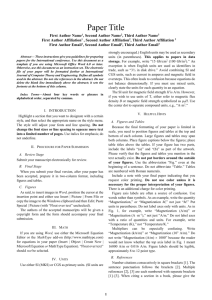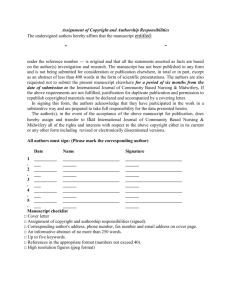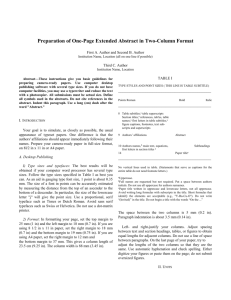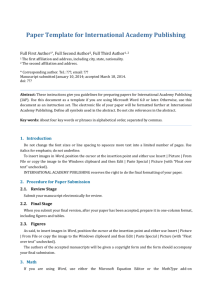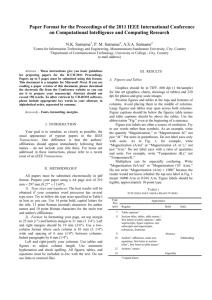Preparation of Papers for RIT Journal of Applied Science and
advertisement
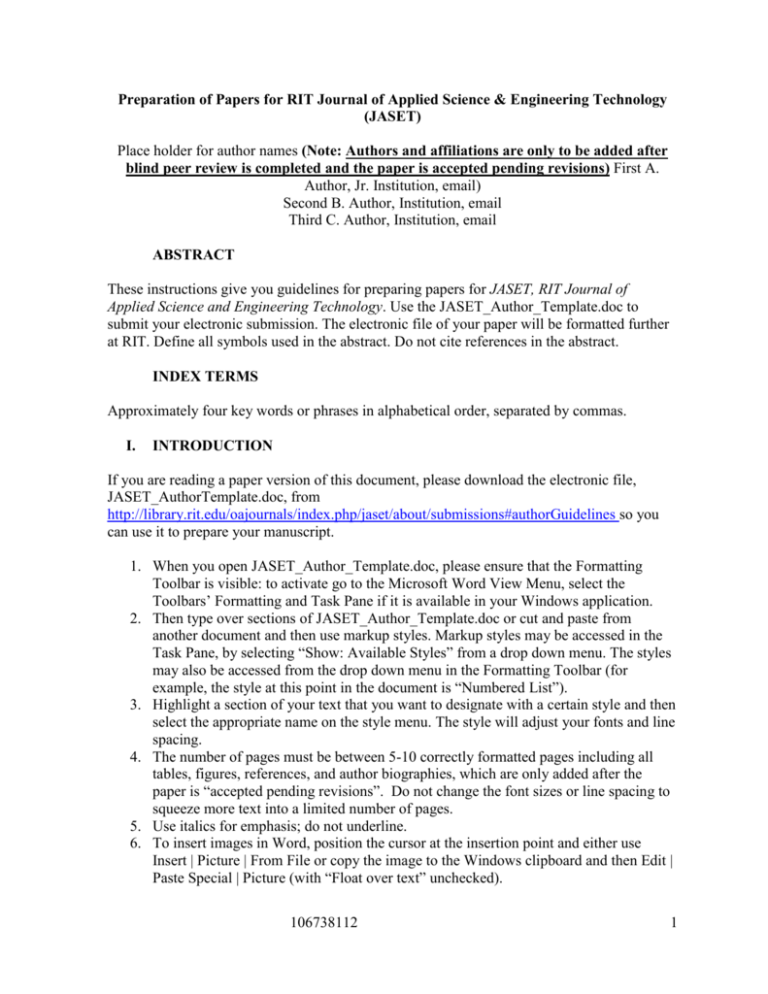
Preparation of Papers for RIT Journal of Applied Science & Engineering Technology (JASET) Place holder for author names (Note: Authors and affiliations are only to be added after blind peer review is completed and the paper is accepted pending revisions) First A. Author, Jr. Institution, email) Second B. Author, Institution, email Third C. Author, Institution, email ABSTRACT These instructions give you guidelines for preparing papers for JASET, RIT Journal of Applied Science and Engineering Technology. Use the JASET_Author_Template.doc to submit your electronic submission. The electronic file of your paper will be formatted further at RIT. Define all symbols used in the abstract. Do not cite references in the abstract. INDEX TERMS Approximately four key words or phrases in alphabetical order, separated by commas. I. INTRODUCTION If you are reading a paper version of this document, please download the electronic file, JASET_AuthorTemplate.doc, from http://library.rit.edu/oajournals/index.php/jaset/about/submissions#authorGuidelines so you can use it to prepare your manuscript. 1. When you open JASET_Author_Template.doc, please ensure that the Formatting Toolbar is visible: to activate go to the Microsoft Word View Menu, select the Toolbars’ Formatting and Task Pane if it is available in your Windows application. 2. Then type over sections of JASET_Author_Template.doc or cut and paste from another document and then use markup styles. Markup styles may be accessed in the Task Pane, by selecting “Show: Available Styles” from a drop down menu. The styles may also be accessed from the drop down menu in the Formatting Toolbar (for example, the style at this point in the document is “Numbered List”). 3. Highlight a section of your text that you want to designate with a certain style and then select the appropriate name on the style menu. The style will adjust your fonts and line spacing. 4. The number of pages must be between 5-10 correctly formatted pages including all tables, figures, references, and author biographies, which are only added after the paper is “accepted pending revisions”. Do not change the font sizes or line spacing to squeeze more text into a limited number of pages. 5. Use italics for emphasis; do not underline. 6. To insert images in Word, position the cursor at the insertion point and either use Insert | Picture | From File or copy the image to the Windows clipboard and then Edit | Paste Special | Picture (with “Float over text” unchecked). 106738112 1 7. We expect authors to format their papers according to these guidelines. Manuscript authors are strongly encouraged to review the Letter from the JASET Editor-inChief titled Navigating the Process of Publishing in a Journal at http://library.rit.edu/oajournals/index.php/jaset/article/viewFile/278/176 PROCEDURE FOR PAPER SUBMISSION A. Review Stage Please submit your manuscript electronically for review. Follow the submission instructions at http://library.rit.edu/oajournals/index.php/jaset/about/submissions#onlineSubmissions B. Final Stage Please submit your final manuscript electronically as a “revision” (this maintains the manuscript number and ongoing revision history) after your paper has been accepted and corrections have been addressed. Follow the submission instructions at http://library.rit.edu/oajournals/index.php/jaset/about/submissions#onlineSubmissions The author who submits the manuscript will be the “corresponding author.” This is the author to whom proofs of the paper will be sent. Proofs are sent to the corresponding author only. C. Copyright Form Authors are responsible for obtaining any necessary copyright permissions. http://library.rit.edu/oajournals/index.php/jaset/about/submissions#authorGuidelines. D. Figures For consistency when preparing tables and figures, use a sans serif font such as “Arial” or “Helvetica.” RIT cannot extract the tables and figures embedded in your Microsoft Word document. (The figures and tables you insert in your document are only to help you gauge the size of your paper, for the convenience of the referees, and to make it easy for you to distribute preprints.) Therefore, submit in separate files, tables, graphs, and image files, using the naming conventions as follows in Section E, “Electronic Image Files.” E. Electronic Image Files The figures in your paper should be ready for print. Please submit graphic files in the following formats: JPEG, TIFF, PDF, Excel. Use a separate file for each image. File names should be of the form “fig2.pdf,” etc. Files should be sized at the intended size of reproduction, or at least 5 inches wide, to maintain optimal readability and resolution. 106738112 2 1. Line figures and tables: Using a scanner, save the images in TIFF format. Highcontrast line figures and tables should be prepared with 1200 dpi resolution and saved with no compression, 1 bit per pixel (monochrome), with file names of the form “fig3.tif” or “table1.tif.” 2. Photographs and grayscale figures: Images should be prepared with 300 dpi resolution and saved with no compression, 8 bits per pixel (grayscale). 3. Color figures: Color images should be prepared with 400 dpi resolution and saved with no compression, 8 bits per pixel (palette or 256 color). II. EQUATIONS If you are using Word, use either the Microsoft Equation Editor for equations in your paper (Insert | Object | Create New | Microsoft Equation.) “Float over text” should not be selected. 1. Number equations consecutively with equation numbers in parentheses flush with the right margin, as in (1). 2. First use the equation editor to create the equation. 3. Then select the “Equation” markup style. 4. Press the tab key and write the equation number in parentheses. 5. To make your equations more compact, you may use the solidus ( / ), the exp function, or appropriate exponents. 6. Use parentheses to avoid ambiguities in denominators. 7. Punctuate equations when they are part of a sentence, as in diL VCC vc R RL iL dt dv v VEE Ce e i L e dt Re L C (1) dvc dv C e iL ic dt dt 8. Be sure that the symbols in your equation have been defined before the equation appears or immediately following. 9. Italicize symbols (T might refer to temperature, but T is the unit tesla). 10. Refer to “(1)” not “Eq. (1)” or “equation (1)” except at the beginning of a sentence: “Equation (1) is ...” III. UNITS Use either SI (MKS) or CGS as primary units. (SI units are strongly encouraged.) English units may be used as secondary units (in parentheses). This applies to papers in data storage. For example, write “15 Gb/cm2 (100 Gb/in2).” An exception is when English units are used as identifiers in trade, such as “31/2 in disk drive.” Avoid combining SI and CGS units, such as current in amperes and magnetic field in oersteds. This often leads to confusion 106738112 3 because equations do not balance dimensionally. If you must use mixed units, clearly state the units for each quantity in an equation. The SI unit for magnetic field strength H is A/m. However, if you wish to use units of T, either refer to magnetic flux density B or magnetic field strength symbolized as µ0H. Use the center dot to separate compound units, e.g., “A·m2.” For more information, please refer to the IEEE Citation and Writing Guideline (Figures section) at: http://library.rit.edu/userservices/pubschol/IEEEGuidelines.pdf or see section V. in this document. IV. HELPFUL HINTS A. Figures and Tables 1. All figures, figure captions, and tables can be at the end of the paper. 2. Large figures and tables may span a whole 8.5 inches wide page. Place figure captions below the figures; place table titles above the tables. 3. If your figure has two parts, include the labels “(a)” and “(b)” as part of the artwork. 4. Please verify that the figures and tables you mention in the text actually exist. B. Figures 1. 2. 3. 4. 5. 6. Please do not include captions as part of the figures. Do not put captions in “text boxes” linked to the figures. Do not put borders around the outside of your figures. Figure axis labels are often a source of confusion. Use words rather than symbols. As an example, write the quantity “Magnetization,” or “Magnetization M,” not just “M.” 7. Put units in parentheses. 8. Do not label axes only with units. 9. For example, write “Magnetization (A/m)” or “Magnetization (A m-1),” not just “A/m.” 10. Do not label axes with a ratio of quantities and units. 11. For example, write “Temperature (K),” not “Temperature/K.” 12. Multipliers can be especially confusing. 13. Write “Magnetization (kA/m)” or “Magnetization (103 A/m).” 14. Do not write “Magnetization (A/m) 1000” because the reader would not know whether the top axis label in Fig. 1 meant 16000 A/m or 0.016 A/m. 15. Figure labels should be legible, approximately 8 to 12 point type. C. Tables 1. Do not abbreviate “Table.” 2. Tables are numbered with Roman numerals. 106738112 4 3. The electronic edition of your paper will be featured in color on the JASET website. D. Footnotes 1. Footnotes should be avoided. Instead, try to integrate the footnote into the text. E. Abbreviations and Acronyms 1. Define abbreviations and acronyms the first time they are used in the text, even after they have already been defined in the abstract. 2. Abbreviations such as RIT, SI, ac, and dc do not have to be defined. 3. Abbreviations that incorporate periods should not have spaces: write “C.N.R.S.,” not “C. N. R. S.” 4. Do not use abbreviations in the title unless they are unavoidable. F. Other Recommendations 1. Use one space after periods and colons. 2. Hyphenate complex modifiers: “zero-field-cooled magnetization.” 3. Avoid dangling participles, such as, “Using (1), the potential was calculated.” [It is not clear who or what was used (1).] a. Write instead, “The potential was calculated by using (1),” or “Using (1); we calculated the potential.” 4. Use a zero before decimal points: “0.25,” not “.25.” 5. Use “cm3” not “cc. 6. The abbreviation for “seconds” is “s” not “sec.” 7. Do not mix complete spellings and abbreviations of units: use “Wb/m2” or “webers per square meter,” not “webers/m2.” 8. When expressing a range of values, write “7 to 9” or “7-9,” not “7~9.” 9. A parenthetical statement at the end of a sentence is punctuated outside of the closing parenthesis (like this). 10. (A parenthetical sentence is punctuated within the parentheses.) 11. In American English, periods and commas are within quotation marks, like “this period.” 12. Other punctuation (!,?) is “outside”! 13. Avoid contractions; for example, write “do not” instead of “don't.” 14. The serial comma is preferred: “A, B, and C” instead of “A, B and C.” 15. If you wish, you may write in the first person singular or plural and use the active voice (“I observed that ...” or “We observed that ...” instead of “It was observed that ...”). 16. Remember to check spelling. If your native language is not English, please have a native English-speaking colleague proofread your paper. V. SOME COMMON MISTAKES 106738112 5 The word “data” is plural, not singular. The subscript for the permeability of vacuum µ0 is zero, not a lowercase letter “o.” The term for residual magnetization is “remanence”; the adjective is “remanent”; do not write “remnance” or “remnant.” Use the word “micrometer” instead of “micron.” A graph within a graph is an “inset,” not an “insert.” The word “alternatively” is preferred to the word “alternately” (unless you really mean something that alternates). Use the word “whereas” instead of “while” (unless you are referring to simultaneous events). Do not use the word “essentially” to mean “approximately” or “effectively.” Do not use the word “issue” as a euphemism for “problem.” When compositions are not specified, separate chemical symbols by en-dashes; for example, “NiMn” indicates the intermetallic compound Ni0.5 Mn0.5 whereas “Ni-Mn” indicates an alloy of some composition NixMn1-x. Be aware of the different meanings of the homophones “affect” (usually a verb) and “effect” (usually a noun), “complement” and “compliment,” “discreet” and “discrete,” “principal” (e.g., “principal investigator”) and “principle” (e.g., “principle of measurement”). Do not confuse “imply” and “infer.” Prefixes such as “non,” “sub,” “micro,” “multi,” and “ultra” are not independent words; they should be joined to the words they modify, usually without a hyphen. There is no period after the “et” in the Latin abbreviation “et al.” (It is also italicized). The abbreviation “i.e.,” means “that is,” and the abbreviation “e.g.,” means “for example” (these abbreviations are not italicized). VI. EDITORIAL POLICY Papers must not have been published previously, or be currently under review in any other publication forum. It is recognized that at times, it is desirable to publish preliminary results in a conference for exposure which allows the technical community to review and comment. These results can later be refined and expanded for publication in a journal, which establishes the work in an archival forum for future reference. Authors are responsible for obtaining any necessary copyright permission. Do not publish “preliminary” data or results in JASET. The submitting author is responsible for obtaining agreement of all coauthors and any consent required from sponsors before submitting a paper. JASET strongly discourages courtesy co-authorship. It is the obligation of the authors to cite relevant prior work. VII. PUBLICATION PRINCIPLES The contents of JASET are double blind peer-reviewed and archival. JASET publishes scholarly articles of archival value as well as tutorial expositions and critical reviews of classical subjects and topics of current interest. Authors should consider the following points: 1. Technical papers submitted for publication must advance the state of knowledge and must cite relevant prior work. 2. The length of a submitted paper should be commensurate with the importance, or appropriate to the complexity of the work. Paper lengths are permitted to be 5-10 106738112 6 formatted pages inclusive of all tables, figures, references and author bios, which are to be added after peer review is successful. 3. Papers must be based upon sound scientific and technical merit as determined by the peer reviewers. 4. Results of the paper must be supported by adequate and accurate data and details. VIII. CONCLUSION Although a conclusion may review the main points of the paper, do not replicate the abstract as the conclusion. A conclusion might elaborate on the importance of the work or suggest applications and extensions. IX. APPENDIX Appendices, if needed, appear before the acknowledgment. X. ACKNOWLEDGMENT The preferred spelling of the word “acknowledgment” in American English is without an “e” after the “g.” Use the singular heading even if you have many acknowledgments. Avoid expressions such as “One of us (S.B.A.) would like to thank...” Instead, write “F. A. Author thanks...” Sponsor and financial support acknowledgments are placed in the unnumbered footnote on the first page. XI. REFERENCES For more information, please refer to the IEEE Citation & Writing Guideline at: http://library.rit.edu/userservices/pubschol/IEEEGuidelines.pdf Helpful Hints: 1. 2. 3. 4. The reference list should appear at the end of your paper. Begin the list on a new page. The title References should be either left justified or centered on the page. The entries should appear as one numerical sequence in the order that the material is cited in the text of your assignment. 5. Number citations consecutively in square brackets [1]. 6. The sentence punctuation follows the brackets [2]. 7. Give all authors' names; do not use “et al.” unless there are six authors or more. 8. Use a space after authors' initials. 9. Papers that have not been published should be cited as “unpublished.” 10. Papers that have been submitted for publication should be cited as “submitted for publication.” 11. Papers that have been accepted for publication, but not yet specified for an issue should be cited as “to be published.” 12. Please give affiliations and addresses for private communications. 106738112 7 XII. BIO-STATEMENT GUIDELINE Note: Bio-Statements are only included AFTER blind review is complete and the manuscript has been accepted pending corrections. Each author should supply brief biography paragraphs of up to 5 sentences. Information here may cover educational credentials, professional memberships, and the mention of a maximum of two publications. F. A. AUTHOR, JR. is with the National Society of Professional Engineers, Alexandria, VA 22314 USA (corresponding author to provide phone: 303-555-5555; FAX: 303-555-5555; email: author@nspe.org). S. B. AUTHOR was with Texas A&M University, College Station, TX 77843 USA. She is now with the Department of Physics, University of Nebraska-Lincoln, Lincoln, NE 68588 USA (e-mail: author@lincoln.edu). T. C. AUTHOR is with the College of Applied Science and Technology, Rochester Institute of Technology, Rochester, NY 14623 USA, on leave from the NRC Institute for Research in Construction, Ottawa, ON, Canada (e-mail: author@nrc-cnrc.gc.ca). This document builds upon guidelines supplied in “Template and Instructions on How to Create Your Paper,” Institute of Electrical and Electronics Engineers, Inc., http://www.ieee.org/web/publications/authors/transjnl/index.html. Original: Marianne Buehler and Amelia Hugill Fontanel Updated: 09-10-2009: Mark Mansfield Updated: 2-10-10 Scott J. Anson, Ph.D., P.E. 106738112 8

